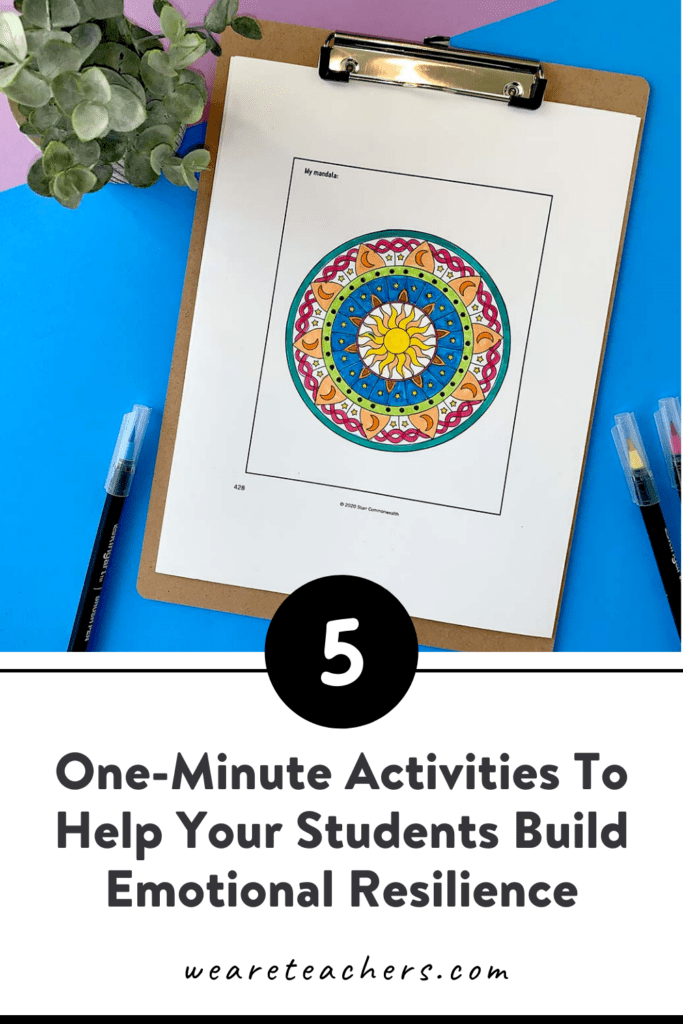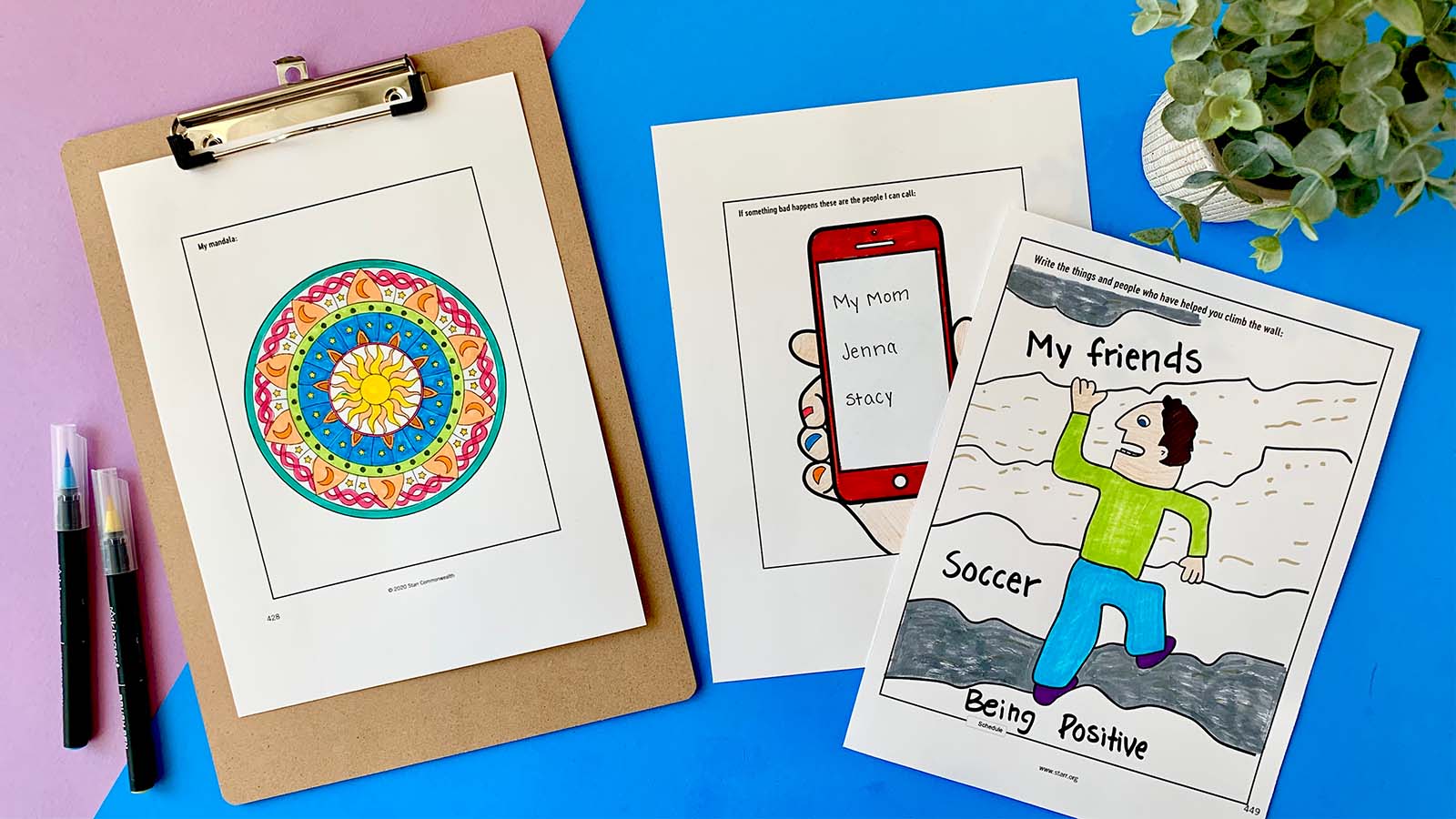Emotional resilience, a person’s ability to “bounce back” after setbacks, to learn from past failures and be willing to try again, is vital to students’ long-term success. We know that this is especially challenging for students dealing with trauma, but it’s important to realize that all students can benefit from spending time developing this skill. The good news is emotional resilience can be taught, practiced, and reinforced. In fact, emotional resilience activities for kids often fit perfectly into lessons involving reading, writing, speaking, and listening, making them perfect mini-lessons in most classrooms.
The following activities are adapted from One-Minute Resilience Building Interventions for Traumatized Children and Adolescents by STARR Commonwealth. This comprehensive collection of emotional resilience activities for kids ages 3-17 breaks the lessons into themes: safety, worry, hurt, fear, anger, relaxation, and survivor. This allows teachers to easily choose an activity based on the unique needs of the students in their class.
1. Safety: If Something Bad Happens, I Can Always Call …

Activity Instructions:
- Print out one copy of the “If Something Bad Happens, I Can Always Call …” page for each student.
- Hand out the papers. As you do, ask students to think of the people and/or organizations in their lives that would help them if they were ever in trouble.
- Explain to the class that when we need something, it helps to have a plan. It helps us to know exactly who we would call and what we would say should we need them.
- Give students time to get several names and phone numbers written on their paper.
- Once each student has several numbers on their paper, put them in pairs or groups. Instruct them to practice what they might say when they call their numbers to ask for help.
- At the end of the activity, encourage students to keep their list of names and numbers in a safe place, so they have it should they ever need it.
How does this develop emotional resilience?
Being able to plan ahead is a skill that can be challenging for students dealing with trauma. When our brains are in survival mode, we focus on the present, not what might happen later on. By giving our students opportunities to practice planning for adversity in safe environments, we’re helping them practice emotional resilience skills they will be able to utilize during potentially traumatic events.
2. Worry: Iceberg
Activity Instructions:
- Print out one copy of the “Iceberg” page for each student.
- As you hand them out, explain to the class that there are things about each of us that many people know. There are things about us that only some people, like our best friends, know. And there are even things about each of us that no one knows! That is OK. Some things are meant to be private.
- Give students time to complete the Iceberg page based on the prompts beside each section of the iceberg. If desired, ask students to share something from the top of their icebergs.
- At the end of the activity, ask students to reflect on their iceberg. Tell students that while some aspects of our lives are private and that is OK, if a secret part of our life is worrying us, it can feel better to share that with someone we trust.
- Ask students to share a time when they thought they were the only one who felt a certain way or were going through a certain experience, but later found out that they really weren’t alone.
- As students put their Iceberg papers someplace safe and private (you may even want to collect them and throw them away to ensure privacy), remind students that sharing our fears with people we trust can make us feel more happy and safe.
How does this develop emotional resilience?
Learning to share our worries with others is one component of emotional resilience. It makes us feel less alone and helps us see the people around us who want to support us during difficult times. Additionally, recognizing that while we may be experiencing a traumatic event, we likely are not the only ones who have lived through something like this, is a beneficial mindset. It encourages our students to look for others who are experiencing challenging times like they are or ask for help from people who have already lived through similar events.
3. Anger: Dashboard Gauge

Activity Instructions:
- Print out one copy of the “Dashboard Gauge” page for each student.
- As you hand them out, explain that the gauges on the dashboard of a car let you know if something is wrong or needs to be attended to. If the car is low on gas, the gauge will point to “E” to let you know. If the tire pressure is low, a picture will light up on the dashboard to make you aware of the problem. The indicators come on well before the situation is serious, so we have time to react and fix the problem.
- Point out the “calm,” “tense,” and “stressed” labels on the gauge on the paper. Ask students to think about how their bodies and minds feel when they are calm. Next, have them write a few words describing that feeling above the word “calm” on the gauge. Repeat the process for “tense” and “stressed.”
- Give students a yellow and a red crayon, colored pencil, or marker. Ask them to think carefully about times when they went from being calm to tense. What made their feelings shift? Are there certain sounds, behaviors, or even people that start to make them feel tense even if they were previously feeling calm?
- Have them draw a line indicating the place where they shift from “calm” to “tense.” Above that indicator line, ask students to describe what things make that switch happen. Repeat the process for the switch from “tense” to “angry.”
- Ask students to brainstorm ways this information might be useful in the future. By recognizing what things tend to make us angry when we first notice the indicators, we can make sure to take a breath, walk away from a situation, or use other coping strategies to stop a “blow-up” from happening.
How does this develop emotional resilience?
Being able to control one’s emotions is often challenging for young people. For children experiencing trauma, this can be an even greater challenge. By practicing self-awareness, students begin to see that they can be in control of their own bodies and emotions. They just need to learn their own warning signs and how to respond to them. This emotional resilience activity can be very beneficial for students who become angry frequently. By referring back to it when you notice a student starting to get upset, it gives that student the power to decide how to act. Feeling powerless is a large component of dealing with ongoing trauma, and this activity helps to combat that.
4. Relaxation: My Mandala

Activity Instructions:
- Print out one copy of the “My Mandala” page for each student.
- Pass out one “My Mandala” page to each student. Provide crayons, colored pencils, and/or markers.
- Give your students plenty of time to calmly color their mandalas. You may want to play quiet or relaxing music while they work. If desired, allow students to chat quietly while you circulate and ask them about their drawings or their conversations. This should be a fun, relaxed time.
- As they finish, discuss why taking time to focus on something like coloring their mandalas was fun and/or relaxing. Remind them that taking time, especially when we feel stressed or anxious, to let our minds quiet down is very healthy. Coloring is one option. Ask them for other activities that allow the mind to quiet down for a bit.
How does this develop emotional resilience?
Finding emotional resilience activities that allow us to slow down and quiet our minds are essential to building emotional resilience. We all need an outlet that gives us a break from our worries or stressors. By giving students time during class to practice activities like this, we are sending a very powerful message. This is important. This is healthy. And it is worth our time. By modeling this for our students regularly, we are helping develop their emotional resilience.
5. Survivor: Rock Climbing Wall

Activity Instructions:
- Print out one copy of the “Rock Climbing Wall” page for each student.
- After passing them out, ask the class to imagine that they have just finished climbing a big rock wall. They are now standing at the top.
- Ask them to think about all the things that helped them reach the top. What has helped them survive despite all of the setbacks, challenges, and adversity they have experienced up to this point?
- Have students write one thing that helped them climb their own mountain in each layer of the rock wall. They can list a personal strength, an activity they enjoy, or someone who helped them.
- If students are willing, ask for volunteers to share the things that help them reach the top of their rock walls despite their challenges.
- Discuss how we all can keep our helping resources in mind when we experience adversity.
How does this develop emotional resilience?
Activities like this one reframe our perspective on the traumas we may have experienced. The activity does not ask students to list hardships they have experienced. Instead, it asks them to notice all the things they used to overcome them. By practicing this, students become better able to recognize who can help them when they are struggling. Knowing that you don’t have to face trauma alone builds emotional resilience.
Why should I bring emotional resilience activities into my classroom?
Helping students develop their emotional resilience has multiple benefits. By experiencing these activities in the presence of a caring adult, students begin to develop coping techniques while simultaneously taking in new experiences that increase their resilience to future trauma. Additionally, increasing a child’s time spent engaging in art, play, or other creative activities are excellent stress-reducing strategies. Since we know stressed brains cannot learn, repeated use of these activities makes it more likely that our students will feel safe, happy, and ready to learn while in our classrooms.
Want more quick and easy emotional resilience activities for kids?
STARR Commonwealth’s collection of over 200 age-specific, sensory-based activities is a perfect addition to any classroom. All of the activities are designed to take less than 15 minutes, many less than 5. Each is tied to trauma and resilience themes and comes with clear instructions and a reproducible worksheet so teachers can feel confident presenting the material.
LEARN MORE ABOUT THIS RESOURCE



